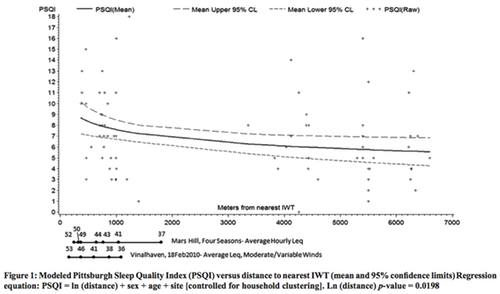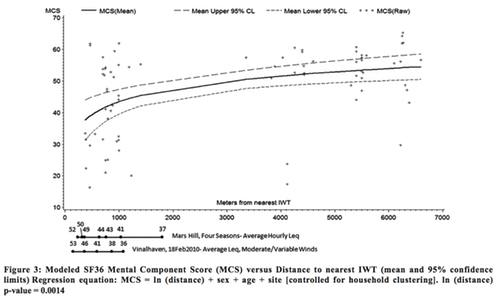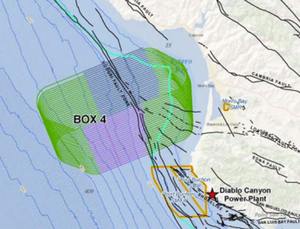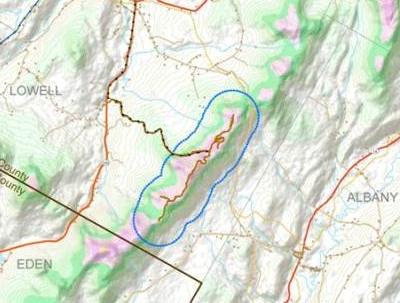AEI lay summary:
Nissenbaum, Aramini, Hanning. Effects of industrial wind turbine noise on sleep and health. Noise & Health, September-October 2012, Volume 14:60, 237-43 Online access
A paper recently published in the journal Noise & Health is getting a fair amount of notice in the media; this article from The Telegraph is perhaps the most detailed coverage, noting that “the findings provide the clearest evidence yet to support long-standing complaints from people living near turbines that the sound from their rotating blades disrupts sleep patterns and causes stress-related conditions.” This article from Ontario includes comments from co-author Jeffery Aramini and Canadian government and wind industry spokespeople.
SEE UPDATE AT BOTTOM OF POST re: Critique of this study contracted by AWEA/CanWEA and released on November 14.
The recent paper is the formal published version of research previously presented at a 2011 conference, and summarized by AEI earlier this year. The study employed three widely-used health questionnaires – Pittsburgh Sleep Quality Index (PSQI) to assess sleep quality, Epworth Sleepiness Score (ESS) to assess daytime alertness, and the SF36 for general mental and physical health – to compare sleep and health among 38 people living within 4600 feet of two wind farms in Maine to that of 41 people living in the same areas, but 2-4 miles from turbines. The authors conclude that “the levels of sleep disruption and the daytime consequences of increased sleepiness, together with the impairment of mental health, strongly suggest that the noise from industrial wind turbines results in similar health impacts as other causes of excessive environmental noise….Industrial wind turbine noise is more annoying than road, rail and aircraft noise, for the same sound pressure, presumably due to its impulsive character. This has led to an underestimation of the potential for adverse health effects of industrial wind turbines.”
The paper is being hailed as solid peer-reviewed proof of sleep and health effects of living near wind farms, though its findings appear less dramatic than the reporting. It certainly does add some important, solid data that will be helpful in quantifying what have been largely anecdotal complaints and case reports. A similarly rigorous survey in New Zealand, using a related WHO health-related quality of life questionnaire, was published in Noise & Health last year by Daniel Shepherd (also included in the AEI summary noted above).
While the new study found average sleep impairment and daytime sleepiness to be higher among those living closer to turbines, and the average “Mental Component Score” of the health assessment being lower among turbine neighbors, the data shows moderate trend lines, rather than dramatic differences. Below is the data for the PSQI (lower scores reflect better sleep):

As you can see, there is a wide scatter of sleep quality – from the top to bottom of the scale – both among turbine neighbors and those living far from turbines. This dramatic individual variability is, I’m sure, typical of the population in general, and so any trend line at all is a finding of note. Still, there appears to be little indication that sleep quality is strikingly worse among neighbors, with the difference being apparent as a modest shift in the average.
The impact on sleep was most significant on those living closest (within 750 meters/2460 feet), where the average PSQI was 8.7, as compared to a PSQI of 5.6 among those living the farthest (over 5300m/3.3miles); there was a much smaller difference between the two middle groups (average PSQI of 7.0 at a 2500-4600 feet versus 6.6 at 2-3 miles). More striking perhaps is that 78% of the nearest neighbors, and 66% of the entire neighbor group, had a PSQI above 5, considered a threshold of concern, as compared to just 44% of those living over 2 miles from turbines (because of the wide scatter, the overall 66/44 difference was not statistically significant). Even more notable may be that 12 (32%) of those within a mile had scores of 10 or more, as compared to only 6 (15%) of those over 2 miles.
Sleep disruption is widely considered a primary precursor for stress and other health effects, including headaches, emotional instability, difficulty concentrating, and possibly higher blood pressure. While this study did not find that those living closer to turbines have any notable difference in the Physical Component Scores (which includes pain, vitality, and physical function), they did find a reduction in the Mental Component Score, which assesses social functioning and emotional problems. As you can see below, while again the trend line shows a modest shift in the average scores, here the distribution of scores is quite dramatically shifted among those living closer:

The overall average MCS was 42 among turbine neighbors, and 53 among those living at a distance; both lie well within the 35-60 range that is considered typical of most people. Those with scores below 30 are at significantly increased risk of clinical depression and need of mental health care; as you can see, the likelihood of this is much higher among those living closer to turbines. We might note as well, though, that there is a solid cluster of turbine neighbors with high MCS scores, which reminds us that negative effects are far from universal. Still, just half as many people closer to turbines score over 60, the point considered a threshold of extremely solid mental health; similarly, only 7 (18%) of neighbors score over 55, as compared to 20 (49%) of more distant residents.
This study is an important step forward in our assessment of sleep and health effects around wind turbines. It’s a stretch to tout the results as “proof of health effects,” as some of the press coverage implies, as the results don’t show dramatic or inevitable effects on sleep, and in fact no difference in overall physical health. However, the study provides quantitative confirmation that living near turbines can have measurable effects, and lays the groundwork for follow up studies. As the authors note in their conclusion, this kind of study needs to be replicated more widely to prove causation, and “further research is needed to determine at what distances risks become negligible, as well as to better estimate the proportion of the population suffering from adverse effects at a given distance.” Here’s hoping that studies like this and Shepherd’s will indeed spur continued research that moves our body of knowledge forward.
And one more finding of note: Among people living 2400-4600 feet (.45-.87 miles)from turbines, 35% said their sleep is worse at home than it is when they go away from the turbines. But twice as many, 70%, said they wish they could move away from the area (78% of those living closer than 2400 feet would also like to leave their homes). This is yet another reminder (as confirmed by the Shepherd study) that severe impacts on quality of life and sense of place are often much more common than are health effects. (In addition to the intrusion on rural sense of home and place for many, impairment of rural quality of life could well trigger to the stress that may underlie some of the health effects.) While it’s important to keep digging to clarify the extent and mechanisms of sleep and health effects, we shouldn’t lose sight of the larger, and in some ways more fundamental, questions about rural quality of life.
UPDATE, 11/16/12: Well, that didn’t take long. AWEA and CanWEA (the US and Canadian wind industry trade associations) commissioned an Ontario environmental sciences firm to review the Nissenbaum et al study; the authors critique the methods and findings as reported. You can see the critique here, or download a version with my comments (some of which agree with the critique, and some of which question whether technical issues really reflect shortcomings in practice). After years of stressing that there’s no data to suggest a relationship between wind farms and sleep or health effects, it seems important to the industry to shoot down the under-funded research that’s taking place where community response has been notable. While it’s certainly valid to point out shortcomings in any research that’s out there, the same degree of diligence is rarely applied toward pointing out the limitations in the studies being cited as indications that health effects are no great concern. This rapid critique is an example of the current internet-driven trend toward waging science by press release (again, not without some justification, since this study is being widely touted as “proof” by anti-wind activists). More useful would be the funding of solid epidemiological studies of health and sleep around operating wind farms, including some where complaints are common and some where complaints are rare.
 NOAA Fisheries announced on Monday that it would review the status of the southern resident population of killer whales, in response to a delisting petition from California farmers. In addition to boat noise, a decrease in salmon runs is a key driver of reduced orca populations, and protection plans for the orcas include protections for salmon, including maintaining river flows. The farmers claim this is denying them the water they need. The heart of the petition is a challenge to NOAA’s determination that this local population is genetically distinct and deserving protection, although the species as a whole is not threatened.
NOAA Fisheries announced on Monday that it would review the status of the southern resident population of killer whales, in response to a delisting petition from California farmers. In addition to boat noise, a decrease in salmon runs is a key driver of reduced orca populations, and protection plans for the orcas include protections for salmon, including maintaining river flows. The farmers claim this is denying them the water they need. The heart of the petition is a challenge to NOAA’s determination that this local population is genetically distinct and deserving protection, although the species as a whole is not threatened.
 The survey
The survey 

 The Lowell Mountain project has been contentious from the start, with
The Lowell Mountain project has been contentious from the start, with